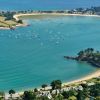Paris is the host for 2024 Olympics – but there are 16 other areas of Metropolitan France, as well as an overseas territory of French Polynesia which will the home to 329 events over 32 different sports.
This year’s event will start on July 26th 2024, and finish on August 11th.
Where will the 2024 Olympics take place?
Paris is the host city for the 2024 summer Olympic Games, however, there will be events spread out across the country.
Three regions are:
- Paris Area
- Île-de-France Area
- Throughout France
The other cities include Versailles, Lille, Vaires-sur-Marne, Marseille, Lyon, Bordeaux, Saint-Etienne, Nice, Nantes, Chateauroux, and Teahupo'o.
In this guide we look at where they are based, and what travellers from the UK can expect.
Paris 2024
The summer Olympics host city will have 13 venues that will be the home for 28 different sports.
During the games, public transport is the best way to travel to venues, so leave your car in a suitable place and head to your nearest bus or train station.
Here are the locations for visitors to look out for:
Bercy Arena
Bercy Arena capacity:
15,000
Sports at Bercy Arena:
Artistic Gymnastics, Basketball, and Trampoline
How to get to Bercy Arena:
Head to the Gare de Lyon stop using the RER A, RER D, Train R, or Metro 1. Visitors will then need to walk 1.1 km walk to reach the venue. It will be signposted for visitors in multiple languages. There is also a Bercy stop for tourists using the Metro 6 / 14 lines, and the site entrance right next to the metro exit.
Champ de Mars Arena
Champ de Mars Arena capacity:
8,356
Sports at Champ de Mars Arena:
Judo and Wrestling
How to get to Champ de Mars Arena:
Use Metro 6 line to La Motte-Picquet-Grenelle.
Eiffel Tower Stadium:
Eiffel Tower Stadium capacity:
>13,000
Sports at Eiffel Tower Stadium:
Beach Volleyball
How to get to Eiffel Tower Stadium:
If you are travelling by train, then use the Pont de l'Alma stop on RER C, and then walk 950 m to reach the venue – or you can visit the Champ de Mars Tour Eiffel stop on RER C, then 600 m walk to reach the venue. Metro stops 6 or 9 and have a walk of les than a kilometre to get the stadium.
Grand Palais:
Grand Palais capacity:
18,520
Sports at Grand Palais:
Fencing and Taekwondo
How to get to Grand Palais:
Using public transport, head to the Franklin D. Roosevelt stop on Metro 1, and then a short 450 m walk to reach the venue. There is also the Invalides stop on RER C or the Invalides stop on the Metro 8 or 13. Both are a short walk to Grand Palais. Olympic organisers have stated that travellers should check if the Alexandrew III bridge is open on the day they travel.
Hotel de Ville:
Hotel de Ville capacity:
5,000
Sports at Hotel de Ville:
Athletics
How to get to Hotel de Ville:
Head for the Metro and get off at Chatelet, Saint-Paul or Pont Marie. They are all a very short walk away to the hotel.
Invalides:
Invalides capacity:
8,000
Sports at Invalides:
Archery, Athletic and Road Cycling
How to get to Invalides:
On the Metro, head to Invalides, La Tour Maubourg or Assemblee Nationale, and they are all less than 50m from the venue. You can also use the RER C, which arrives just outside Invalides.
La Concorde:
La Concorde capacity:
25,000
Sports at La Concorde:
Basketball, Breaking, BMX and Skateboarding
How to get to La Concorde:
On the RER line, head to Auber or Musee d’Orsay – however the second one will mean a 1km walk. Metro users should head to Palais Royal-Musee du Louvre or Madeleine stops – all of which will leave a short walk to La Concorde.
Parc des Princes:
Parc des Princes capacity:
48,583
Sports at Parc des Princes:
Football
How to get to Parc des Princes:
Due to the size of the venue, organisers suggest using the RER C line to Pont du Garigliano – however, there is a 1.7km walk. For Metro 10, head to Port d’Auteil; and for Metro 9, head to Porte de Saint Cloud or Marcel Sembat.
Pont Alexandre III:
Pont Alexandre III capacity:
26,000
Sports at Pont Alexandre III:
Cycling, Marathon Swimming, and Triathlon
How to get to Pont Alexandre III:
On Metro 1/9, head to Franklin D. Roosevelt, and for Metro 13/8, head to Invalides.
Porte de la Chapelle Arena:
Porte de la Chapelle capacity:
8,000
Sports at Porte de la Chapelle:
Badminton and Gymnastics
How to get to Porte de la Chapelle:
Organisers suggest that travellers should use the RER E line to Rosa Parks stop – and then walk just over a kilometre to get to the venue. There is also a Metro 12 stop at Porte de la Chapelle that will leave you a 300m walk.
Stade Roland-Garros:
Stade Roland-Garros capacity:
15,225
Sports at Stade Roland-Garros:
Tennis and Boxing
How to get to Stade Roland-Garros:
You can either use the RER C line to Avenue Foch or the Metro 2 or T3B line to Porte Dauphine. Both locations then offer a free shuttle to the stadium.
South Paris Arena:
South Paris Arena capacity:
6,650
Sports at South Paris Arena:
Handball, Table Tennis, Volleyball, and Weightlifting
How to get to South Paris Arena:
Metro 12 to Porte de Vanves, Metro 8 to Balard, Metro T3A to Georges Brassens and Metro 12 to Porte de Versailles all head to the area where the venue is located. However, organisers recommend that visitors head to the first two, even though they are longer walk away.
Trocadero:
Trocadero capacity:
>13,000
Sports at Trocadero:
Athletics and Cycling
How to get to Trocadero:
Use the RER C line to Pont de L’Alma or the Metro 9 to Lena.
Driving to Paris for the Olympics
Driving from the UK to Paris for the 2024 Olympic Games can be the best way to enjoy the greatest sporting event in the world.
Here is a comprehensive guide to help you plan your journey:
Preparing for the Trip
Ensure you have a valid passport, driver’s license, travel insurance, car insurance, European Breakdown Cover, and emission sticker for Paris.
Drivers will also need to carry out maintenance checks, so that your car is in good enough condition to travel into Europe.
Next, you’ll need to decide if you will take the ferry or Eurotunnel: The ferry from Dover to Calais takes about 90 minutes, and the Eurotunnel from Folkestone to Calais takes about 35 minutes.
From Calais, the drive to Paris is approximately 300 km (186 miles) and typically takes about 3 hours via the A26 and A1 motorways.
All drivers should be aware of the toll roads, speed limits, and common French road signs before setting off on their journey.
Staying in Paris
Unsurprisingly, the French capital is going to be very busy this summer. Therefore, hotels and travel will be more expensive than they usually are.
This includes parking – which will be at a premium, and something that you should organise before leaving for France.
Check if the venues you are visiting have dedicated parking facilities. It may be easier to park outside the city centre and use public transport – or the shuttle services on offer throughout the city.
Consider getting a Navigo travel pass for unlimited travel on the metro, buses, and trams. Also, transport apps like Citymapper or the official RATP app are helpful to navigate public transport efficiently in Paris.
Finally, make sure you have your Olympic tickets well in advance. Check the official Olympics website for updates and ticket availability.
If you are looking to see more than one event, keep an eye on the official Olympic schedule, and see how easy it is to get from one venue to another.

Instant cover available
• 24/7 rescue at the roadside
• Help to get home if your vehicle can't be fixed
• 5 star Defaqto rated cover

What is the Île-de-France Area?
The Île-de-France area, also known as the Paris Region, is the most populous region of France and includes the capital city, Paris, and the surrounding area.
Located in the north-central part of France, it incorporates eight sub-regions, including Central Paris, Seine-et-Marne, Yvelines, Essonne, Hauts-de-Seine, Seine-Saint-Denis, Val-de-Marne, and Val-d'Oise.
The area stretches for around 5,000 square miles and is home to more than 12 million people.
As it covers the capital city, historic landmarks can be found in the region, including the Eiffel Tower, Louvre Museum, Notre-Dame Cathedral, and the Champs-Élysées.
Île-de-France Area venues
There are 12 locations for the Paris 2024 Olympics at the Île-de-France area, where 20 sports will be played.
The Aquatics Centre and Le Bourget Climbing Wall:
Aquatics Centre capacity
5,000
Sports at Aquatics Centre
Swimming, Diving, Water Polo, and Sport Climbing
How to get to Aquatics Centre:
The two best options are to use the RER D line to Stade de France Saint-Denis and walk just over a kilometre – or Metro 14 to Saint-Denis-Pleyel and walk 1.5km.
Chateau de Versailles:
Chateau de Versailles capacity:
>40,000
Sports at Chateau de Versailles:
Equestrian and Modern Pentathlon
How to get to Chateau de Versailles:
Use the RER C out of Paris on the L, N or U lines to all Versailles stops. Each one has a free shuttle to the chateau.
Elancourt Hill:
Elancourt Hill capacity:
15,000
Sports at Elancourt Hill:
Mountain Cycling
How to get to Elancourt Hill:
Head for the Saint-Quentin-en-Yvelines stop on the Line N from Paris towards Rambouillet or the Line U from Paris towards La Verrière. Visitors could also use the RER C from Paris towards Saint-Quentin-en-Yvelines. Each location has a free Paris 2024 shuttle bus.
Le Golf National:
Le Golf National capacity:
80,000
Sports at Le Golf National:
Golf
How to get to Le Golf National:
Use the RER line to Massy Palaiseau from Paris and ten use the free shuttle bus.
North Paris Arena:
North Paris Arena capacity:
6,000
Sports at North Paris Arena:
Boxing and Modern Pentathlon
How to get to North Paris Arena:
Use the RER B line to Parc des Expositions and then walk 400m to the venue.
Paris La Defense Arena:
Paris La Defense Arena capacity:
>40,000
Sports at Paris La Defense Arena
Swimming and Water Polo
How to get to Paris La Defense Arena
Visitors will need to use the RER A line to La Defense or Nanterre-Prefecture – both leave a short walk to the arena.
Saint-Quentin-en-Yvelines BMX Stadium and Velodrome:
Saint-Quentin-en-Yvelines BMX Stadium capacity:
>6,000
Sports at Saint-Quentin-en-Yvelines BMX Stadium:
BMX and Cycling
How to get to Saint-Quentin-en-Yvelines BMX Stadium:
Use the RER C line from Paris to Saint-Quentin-en-Yvelines and then it is just a short walk to either venue.
Stade de France:
Stade de France capacity:
80,000
Sports at Stade de France:
Athletics and Rugby Sevens
How to get to Stade de France:
As it is one of the country’s most popular tourist destinations, there are many ways to get there. Use Metro stations Saint Denis Pleyel, Front Populaire or Saint Denis Porte de Paris; or RER lines to Stade de France Saint Denis or Stade de France La Plaine.
Vaires-sur-Marne Nautical Stadium:
Vaires-sur-Marne Nautical Stadium capacity:
15,000
Sports at Vaires-sur-Marne Nautical Stadium:
Canoe Slalom, Canoe Sprint, and Rowing
How to get to Vaires-sur-Marne Nautical Stadium:
Organisers suggest using the RER A line to Marne La Vallee Chessy to Busy Saint Georges station and then use the free shuttle service. You can also use the RER E line to Gelles Gournay and use the free buses available.
Yvesa-du-Manoir Stadium:
Yvesa-du-Manoir Stadium capacity:
15,000
Sports at Yvesa-du-Manoir Stadium:
Hockey
How to get to Yvesa-du-Manoir Stadium:
You’ll need to cat the Transillien Paris Saint Lazare train service – known as Ligne J – from Paris to Le Stade.
Venues throughout France for 2024 Olympics
There are 10 venues outside of Paris and the Île-de-France area at this year’s summer Olympics – where six sports will be played over the event.
Bordeaux Stadium:
Location:
Bordeaux
Bordeaux Stadium capacity:
42,115
Sports at Bordeaux Stadium:
Football
How to get to Bordeaux Stadium from Paris:
Head south on the A10 and A11 for around 580km – and the journey will take around six hours.
Chateauroux Shooting Centre:
Location:
Chateauroux
Chateauroux Shooting Centre capacity:
3,000
Sports at Chateauroux Shooting Centre:
Shooting
How to get to Chateauroux Shooting Centre from Paris:
Head south on the A10, A71, A20, and N151 to northern Chateauroux for 280km for around three hours.
Geoffroy-Guichard Stadium:
Location:
Lyon
Geoffroy-Guichard Stadium capacity:
41,965
Sports at Geoffroy-Guichard Stadium:
Football
How to get to Geoffroy-Guichard Stadium from Paris:
Head south on the A10, A71, A89, and A72 to south western Lyon. The journey is around 550km and will take around five and a half hours.
La Beaujoire Stadium:
Location:
Nantes
La Beaujoire Stadium capacity:
35,322
Sports at La Beaujoire Stadium:
Football
How to get to La Beaujoire Stadium from Paris:
Head south west on the A6, A10, A11, and A811 to northern Nantes. It is around 390km by car and will take just over four hours.
Lyon Stadium:
Location:
Lyon
Lyon Stadium capacity:
59,186
Sports at Lyon Stadium:
Football
How to get to Lyon Stadium from Paris:
Head south on the A6 and A46 to western Lyon. The journey takes over five hours and is just under 500km.
Marseille Marina:
Location:
Marseille
Marseille Marina capacity:
14,000
Sports at Marseille Marina:
Sailing
How to get to Marseille Marina from Paris:
To reach the southern tip of France from Paris, you’ll need to drive along the A6 through Lyon, then carry on the A7 to Capitainerie du Vieux port to the east of Marseille. The journey will take around eight hours and is around 800km.
Marseille Stadium:
Location:
Marseille
Marseille Stadium capacity:
67,394
Sports at Marseille Stadium:
Football
How to get to Marseille Stadium from Paris:
Drive south on the A6 through Lyon, then carry on the A7 to Marseille. The journey will take around eight hours and is around 800km.
Nice Stadium:
Location:
Nice
Nice Stadium capacity:
36,178
Sports at Marseille Stadium:
Football
How to get to Nice Stadium from Paris:
Head south on the A6 and A7 to Marseille and then head east on the A8 to Nice. The drive will take almost 10 hours and will be around 950km.
Pierre Mauroy Stadium:
Location:
Lille
Pierre Mauroy Stadium capacity:
50,186
Sports at Pierre Mauroy Stadium:
Basketball and Handball
How to get to Pierre Mauroy Stadium from Paris:
Head north on the A1 to southern Lille. The journey is 230km and will take around three hours.
Teahupo’o:
Location:
Tahiti, French Polynesia
Capacity:
>1,000
Sports at Teahupo’o:
Surfing
How to get to Teahupo’o from Paris:
The flight from Paris to Tahiti last more than 22 hours. Then there is a 75km drive from the airport.
Olympic Torch relay stages
The Olympic Torch Relay is a ceremonial event that signifies the countdown to the start of the Olympic Games.
The flame is ignited by the sun's rays at the Temple of Hera in Olympia, Greece, using a parabolic mirror to focus the sunlight. This ceremony marks the official start of the relay.
It then travels from Olympia to the host city of the Olympic Games – Paris, France.
The route typically includes stops in various cities and landmarks, allowing as many people as possible to witness the flame.
For this year’s Olympics, the flame will leave Greece and head to France and several overseas territories.
From April 15th to May 23rd, the Olympic torch visited Marseille, Toulon, Arles, Montpellier, Bastia, Perpignan, Carcassonne, Toulouse, Auch, Tarbes, Pau, Perigeux, Bordeaux, and Angouleme.
After this, the flame will travel until July 25th, when it will arrive at the Opening Ceremony.
Before then it will visit Vienne, Chateauroux, Angers, Laval, Caen, Manche, Renes, Niort, Vendee, La Baule-Escoublac, Vannes and Brest.
On June 8th, it will go to French Guiana on the north coast of South America. It will continue its international trip to New Caledonia, Reunion, French Polynesia, Guadeloupe, and Martinique.
Nine days later it will return to the mainland for the final few days of its journey, where it will go through Nice, Avignon, Valence, Vichy, Saint Etienne, Chamonix, Besancon, Strasbourg, Metz, Saint-Dizier, Verdun, Reims, Lille, Lens, Amiens, Le Havre, Vernon, Chartes, Blois, Orleans, Auxerre, Dijon, Troyes, and finally across the Île-de-France region.
Although there isn’t long left to see the torch relay, they are usually free and open to the public. Check the schedule and plan accordingly to see history take place.
If you are heading south to France this summer, have an amazing time at the Olympic Games.

Instant cover available
• 24/7 rescue at the roadside
• Help to get home if your vehicle can't be fixed
• 5 Star Defaqto rated cover











